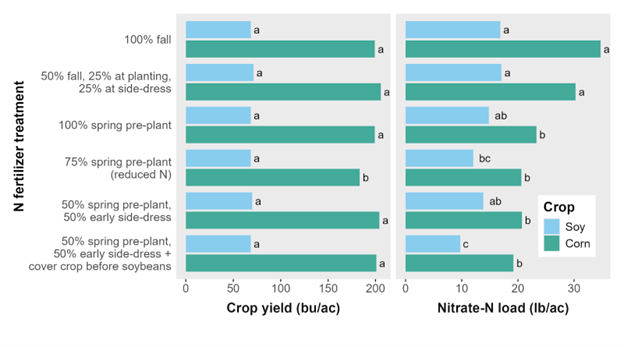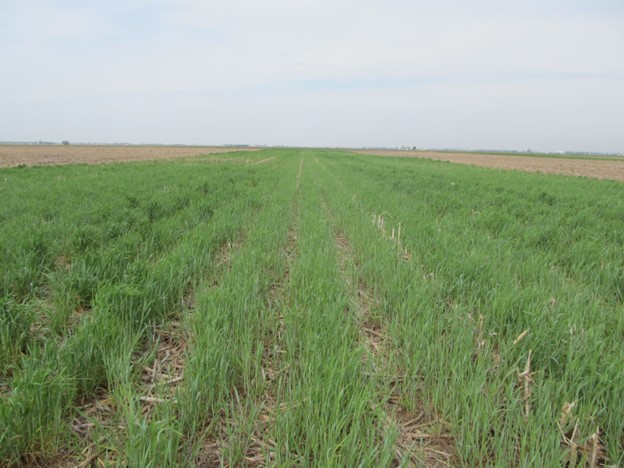Soil nitrogen, in the form of nitrate, is highly soluble and held weakly to soil which can be a cause of concern for water quality when rain or irrigation moves nitrate below the root zone into tile lines or groundwater. Largely from fall applied nitrogen, asynchronous availability of plant N and uptake of N can result in high tile nitrate concentrations in the spring when crops are not growing. Using 4R management of nutrient stewardship, farmers aim to maximize crop fertilizer N uptake to minimize the exposure of large soil nitrate pools to N loss processes such as leaching and denitrification. As a form of non-point pollution, nitrate is a nutrient that contributes to the large hypoxic zone in the gulf draining the Mississippi River Basin. Through the framework set out by the U.S. EPA, the Illinois Nutrient Loss Reduction Strategy (NLRS) has set out a long-term goal of 45% reduction in total phosphorus (P) and nitrogen (N), including a goal of reducing 15% nitrate-nitrogen from the three sectors (agriculture, point source, urban stormwater) by 2025. Per the most recent report (2023) Illinois is not on track to meet these targets, and there is a significant need for more conservation practices on Illinois farms.
In Illinois, 22 million acres, or 60% of the state’s land, is dedicated to corn and soybeans every year. According to research by Lowell Gentry at the University of Illinois, the relative proportions of nitrate delivered to tile lines are split between the two crops, with 60% generally occurring during the corn phase and 40% occurring during the soybean phase. Breaking down the seasonality of nitrate loading shows that springtime is highest and can surpass the EPA’s allowable drinking limit of 10 mg per liter of nitrate measured as nitrogen. When drinking water supplies exceed this limit municipalities have had to distribute bottled water to residents.
Minimizing nitrate leaching from croplands is possible with appropriate cropland management. Regarding fall N storage and application, Dan Schaefer mentioned:
“the worst place to store nitrogen for six months is in the soil”
So, a straightforward and effective solution to reducing leaching is timing N applications when actively growing roots are present. Moving application of fall N to the spring is a primary step towards reducing tile N as spring-applied N is more likely to be taken up by the corn crop.
Mr. Gentry’s research bears this out and was the featured topic at a recent discussion hosted by ISAP’s Science Committee. Data from field trials on a flat, tile-drained prairie mollisol site in Douglas County compared corn fields with 100% fall application with 100% spring pre-plant application. The corn yields were the same but nitrate loads to the tiles were 33% lower with spring application (see Fig. 1). Adding a cover crop before soybeans to a spring-only split application can cut tile nitrate losses by 44% across the corn and soybean phases combined compared to a fall-applied system, while maintaining cash crop yields. It is interesting to note the tile loading benefit in the soybean years when no fertilizer was applied (Fig. 1, bottom right blue bar).
The split application involved applying half of the N fertilizer before planting and the other half a few weeks after planting. Mr. Gentry suspects that an ideal schedule for a prairie Mollisol like this, which has plenty of organic N to mineralize in the spring, could actually be half or even a third of the N applied at planting, instead of pre-plant, and the remainder applied a few weeks later. This would reduce both the number of passes required and the risk of N losses that could occur between a pre-plant application and crop germination and uptake. Unfortunately the field study was not designed to test this, but Lowell has observed this on a collaborating farm in the area. A cropping system on a soil with less mineralizable N may need that pre-plant application and/or a greater fraction of N at planting.

Figure 1. Crop yields and nitrate-N loading to tile drains across six nitrogen fertilizer treatments in a corn-soybean rotation in Douglas County, Illinois. The yields and loads are the annual average for years 2016-2019. Letters indicate significant differences between bar size within crop types, e.g., comparing corn yields to each other and separately comparing soybean yields to each other). Data source: Gentry et al. (2024).
The other part of the equation is the incorporation of cover crops into this two-year rotation. Tile nitrate loads are lowest during the summertime when corn and soybeans are growing, so applying that logic to cover crops during the shoulder seasons is a way to further reduce leaching potential. Data from Lowell’s research shows that 1.5 tons (T) per acre of winter cereal rye biomass resulted in a 45% reduction in tile N ahead of soybeans (Gentry et al. (2024). To achieve this, Mr. Gentry recommends drilling cereal rye after harvest for good establishment and leave to grow to about 16-18” tall. While it might look unassuming aboveground, the roots are doing important work below ground (Fig. 2). By restructuring the fertilizer program ahead of corn and incorporating cereal rye post-corn ahead of soybean, Lowell is confident that the goals of the NLRS could be achieved.

Figure 2. Cereal rye cover crop planted in central Illinois. (Photo courtesy of Lowell Gentry).
To limit impacts to corn and soybean yields, it is important to not let cereal rye accumulate too much biomass. Despite 2T-2.5T reducing tile N 80-90%, the higher end of that biomass range is where yield issues can materialize. It is also understood that cereal rye ahead of corn is not advised due to the nutrient requirements and N immobilization potential cereal rye poses for corn.
Understanding the science of nitrogen management can help farmers be better stewards. Mr. Gentry’s data show how shifts in N application timing and planting a cover crop before soybeans is a major step in the right direction.